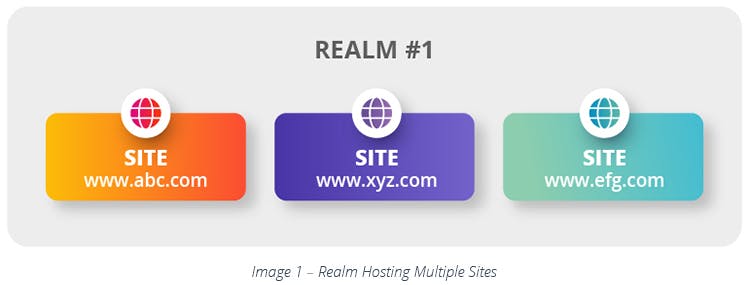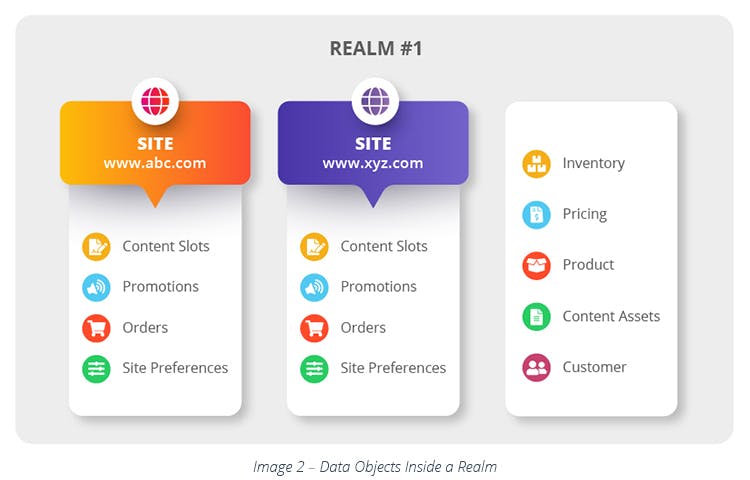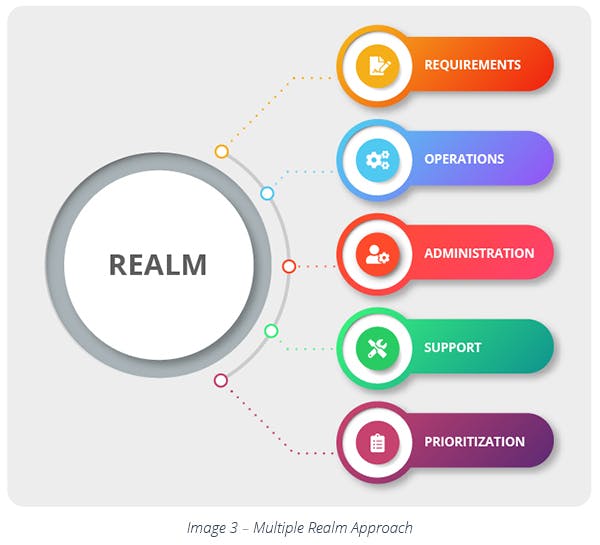Simply put, a realm is a combination of instances (application infrastructures) where you can build, test, or deploy your e-commerce website.
When managing multiple brands/websites on Salesforce Commerce Cloud, it’s important to know the type of realm that will work best for your brand – whether to utilize multi-realms to develop, configure, or manage multiple websites, or opt for a single realm for all of them?
To help you find the solution that fits best for your e-commerce business, in this blog, we’ve explained the relationship between realms and sites, their benefits and limitations with respect to business objectives.
Let’s dive deep into the subject by understanding the true essence of ‘realms’ and ‘sites’ in the context of Salesforce Commerce Cloud.
Realms in Salesforce Commerce Cloud
A realm in Salesforce Commerce Cloud is a piece that describes the aggregation of service (both software and hardware) that Salesforce provides to its customers. Further, a realm contains instances that include web servers, application servers, and database servers. Typically, a realm consists of two groups: a primary instance group (PIG) and a secondary instance group (SIG).
A customer receives 9 instances per realm - 3 instances for staging, testing, and deployment on the PIG and 5 sandbox instances for code development on the SIG. To scale, customers can have up to 47 sandboxes per realm (most of which are available for a fee). A specific point of delivery (POD) serves the realm, located in a single data center.
Sites in Salesforce Commerce Cloud
A realm is designed to host multiple sites in Salesforce Commerce Cloud.

The designs of data objects inside a realm are shareable across all sites and can be local to a specific site. For example:
Shared Objects
- Inventory | Pricing | Products and Product Photography | Custom Code | Customers | Content Assets
Site-specific Objects
- Content Slots | Orders | Promotions | Site Preferences or Configurations

Single vs. Multiple Realms – The Right Approach
Each approach has its pros and cons. Let’s go through the details.
Single Realm
Pros:
- Leverages same core codebase
- Easy to maintain
- Better for small teams
Cons:
- The customization specific to the site is difficult to maintain.
- A shared codebase dictates the business requirement. A functionality becomes a priority only if it benefits all brands and not for a specific requirement of an individual brand.
- Roll-out or release (good or bad) for global code affects all brands.
When to Adopt a Single Realm Approach
The sites within a realm have an inherent relationship with respect to their management – specifically related to operational and administrative tasks such as:
- Data Replication | Code Deployment | User Rights and Administration
Since many objects are shareable across all sites within a realm, a business can streamline merchandising, development, QA, support, and maintenance of their sites within a realm. This streamlining creates significant efficiencies and scalability when compared against solutions that include redundant processes and multiple databases that need synchronization.
Generally, all sites within a realm share a merchandising team or at least reflect a business where the merchandising teams work collaboratively on schedules, processes, and priorities. They also share an admin, development, and operations team.
Code, jobs, processes, and functionality needs to be scheduled, prioritized, and configured in such a way that addresses the needs of all sites within the realm. On the downside, creating individual control at a site level in these areas is nearly impossible within a realm due to inherent sharing, which is architected within the sites in a realm.
Note: This sharing does not limit the differentiation of sites within a realm but does limit the business processes and operating models of the sites within a single realm.
Multiple Realm
Pros:
- Flexibility in having different code and functionality
- The global code does not affect all brands – it will only affect the brands in that realm
- Different business requirements or logic can run independently if the code is for a different brand
Cons:
- A higher infrastructure cost
- A new STG, QA, PROD instance is required to push code from a lower environment to a production environment
- New Sandboxes are required since a different set of code is being developed and maintained
When to Adopt a Multiple Realm Approach
Customers who use this approach, in general, have different partners or development teams responsible for the site in each unique realm. These customers also have business teams who can define, prioritize, fund, and execute initiatives independently from each other (this usually means their P&L report into different business units).
Customers who leverage multi-realm benefit from the differentiation in how business processes are defined and managed while benefiting (in an offline manner) from the native compatibility of the Salesforce Commerce Cloud architecture (importing or exporting from real to realm is easy).
How to Maintain Brand Consistency Using a Multiple Realm Approach:
- Align your business units or brands or regions
- Identify and acknowledge organizational constraints or culture that makes sich alignments difficult to attain

| Single Realm | Multiple Realm |
|---|---|
| Single Partner or Development Team | Multiple Partners or Development Teams |
| Common Code and Release Schedules | Divergent Code and Release Schedules |
| Shared Merchandising Practices (common view) | Divergent Merchandising Practices (isolation) |
| Shared Support and Maintenance Team | Divergent Support and Maintenance Team |
| Common Project Prioritization and Resourcing | Unique Project Prioritization and Resourcing |
| Shared User Rights Management | Unique User Rights Management |
Conclusion
A realm architecture (single or multiple) is a decision that has both financial and operational implications. However, since code and data are transportable between realms, it is possible to re-architect the user of realms over time as the business evolves. For example:
- Allow a site – or a set of sites – to move from a shared realm to one of their own, as business results justify the financial aspect.
- Alternatively, merging site(s) from multiple realms into a single realm is a bit more of a challenge as it likely requires code refactoring.
Regardless of the commercial impact of the multiple realm approach, building a realm architecture solution where multiple realms are needed should be avoided at all costs as it will make it difficult (if not impossible) to achieve the business objectives.
If you’re facing performance issues with your Salesforce Commerce Cloud e-commerce website, then you can implement these 6 easy techniques to make your Salesforce Commerce Cloud website faster to improve the website conversion rate.



